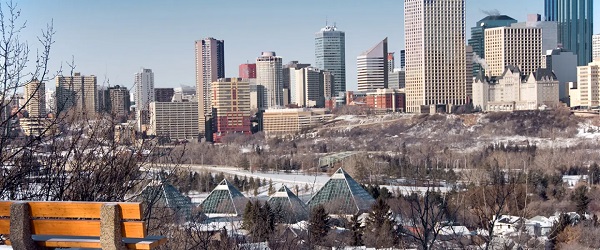Calgary
Forget the Horizon, Downtown Calgary is in Big Trouble Right Now

Do you travel through or live in downtown Calgary?
Do you glare at our skyscrapers and see only a few lights on?
This is a tale of a cowtown that stopped producing milk, even our ranch has closed. If there was a light at the end of this tunnel, not even our top economic spokespeople can offer any of us a realistic answer for where we are at now, or when we will even see the light. The economic destruction from COVID-19 continues to ravage the health of local businesses and almost every other industry that calls our city home. With that, there is a lot more to the story that reaches beyond March of this year. The question is, what does a pillar city in Canada do when their downtown is empty and graduates continue to emigrate?
Recent data from the CBRE from Q3 of 2020 show the office vacancy in downtown Calgary has hit 28.7%. That number may seem irrelevant without comparison to other metropolitan places in the country. The chart below shows the office vacancy percentages based on data collected of unused office space by square footage in the downtown core in each identified city.

Data Sourced: CBRE, “Canada’s Office and Industrial Quarterly Statistics Q3 2020”, CBRE.ca
The clarification we are lacking is that there is a very real problem with attracting commercial activity. The challenge lies within the lack of large firms that have more than 1,000 employees to fill these empty sky-high office buildings.
We cannot simply just ask companies to move their workforce, an example being Suncor’s recent decision to uproot 700 employees from Ontario to relocate to Calgary. Better described as 700 humans with families, friends and communities in Ontario. No figures have been released to state how many jobs will be coming to Calgary.
Almost within the same week, we see the consolidation of Husky Energy by Cenovus. This does make “fiscal” sense for the financial health and future of the company, becoming the third-largest oil and natural gas producer in the country. Citing a piece in the Financial Post by Diane Francis, Cenovus will close the Husky head office in Calgary, which is not reflected in the Q3 data released by the CBRE.
If we keep in mind that the headquarters for Husky Energy Inc was Western Canada Place, where we saw the Apache Corporation “strategically exit” Canada back in 2017. It will become clear in the near future that we could see another tenant evacuation of a huge building in downtown Calgary.
One piece of that 28.7% of our current office vacancy is due to Nexen leaving their building on 8th street completely vacant, setting up shop in the same building as the newly purchased Husky Energy Inc. In this case, bottom level retail such as cafe’s are not included as occupied office space.
If there are corporate tax incentives in almost every major city in the efforts of attracting big business, therein lies the question. What else can Calgary offer to sway large firms to come here? Take a look at the chart below stating the 2020 Corporate Income Tax Rates in Canada.

Source: TaxTips, “2020 Corporate Income Tax Rates”, Taxtips.ca
At some point in the recent history of Alberta, competitiveness turned into desperation. There is some benefit to local entrepreneurs looking to set up a business by lowering the barrier to entry, however, have we really seen that as a result of the lowest corporate tax rates in the country?
Looking at the fact sheet prepared by Calgary Economic Development in May of this year. As shown in the chart below, take a look at the new and renewed business licenses. It is crucial to note that COVID-19 has created a mountain of economic problems for almost every city, which we can assume had a major impact on the 2020 numbers seen below. We may see this continuing to decline as the pandemic continues to ravage our economy.
In addition, it is important to note the lack of new business licenses issued since 2017. This is not a new problem but has been exacerbated by COVID-19.

Calgary Economic Development, “Fact Sheet: Calgary Small Business”, 2020 Edition Published: June 24, 2020, p 6., Calgaryeconomicdevelopment.ca
When faced with a challenge, Calgarians do not quit. The piece of the puzzle that has yet to be found is to restore incentive to local and foreign investment. The ideology that big tech would eventually be “sold” on Calgary’s infrastructure has not gained traction.
Recent history teaches us that big tech follows big tech, an example being TikTok opening a new headquarters in Dublin back in August of this year, where companies such as Alphabet, Amazon, eBay, Paypal and Facebook also have European headquarters. While these names are well-known globally, the economic and sociological effect it could have on our city would offer Calgarians some indication that we are actually progressing in some way.
Consider being a graduate enrolled in an extensive and expensive program this year. The lack of economic progress is tied with the lack of jobs in a psychologically destructive way. If we cannot incentivize foreign investment and create new job opportunities, more importantly, how do we hold on to waves of eager graduates that are well aware of the benefits of moving to other cities or countries?
The narrative that new graduates carrying thousands of dollars in debt are given any chance to achieve anything close to previous generations in Calgary back in the high oil and gas days is now an irrelevant argument. Understandable that they may pack up and leave for greener pastures.
The evidence is in the 2019 Calgary Civic Census. The age demographic of 20-24 is our second lowest age demographic sitting at 5.94%, the lowest being the 15-19 year olds sitting at only 5.28%. The chart below shows the breakdown of our Calgary’s age segmentation.

Source: Calgary Civic Census 2019, “Civic Census Results 2019”, Calgary.ca
Cities such as Vancouver and Toronto last conducted their population census in 2016. The comparison data ranked Calgary 29th out of 35 cities in Canada for the age demographic of 20-24. Thinking about the cities you are aware of in Canada, to not even rank in the top 10 for young adults adds to the enormous problem we will be attempting to remedy for an unknown amount of time. This data can be seen clearly in a CBC post relating to this issue.
The information above may offer some real data that has very real implications. However, the narrative less documented is what sentiment do young people feel in Calgary and what is left to be proud of. It cannot just be the Stampede or nothing at all. Even after emigrating to another city or country, what is it that they tell their newfound community about their home city? The vibrant, creative and hard-working young people in this city have a fighting chance, but only if there is some benefit to their future staying here. Without awareness of foundational values, celebration of culture and real opportunity to rely upon in your city, understandably, young people will continue to leave and seldomly will ever return.
________________________________________________________________________________________________________________________
References:
Calgary.ca, “Calgary Civic Census 2019.” 2019 Civic Census Results, 2019, p. 18, Calgary.ca.
CBRE, “Canada’s Office and Industrial Quarterly Statistics Q3 2020”, CBRE.ca.
Calgary Economic Development, “Fact Sheet: Calgary Small Business”, 2020 Edition Published: June 24, 2020, p 6., Calgaryeconomicdevelopment.ca
________________________________________________________________________________________________________________________
For more stories, please visit Todayville Calgary
Alberta
Calgary mayor should retain ‘blanket rezoning’ for sake of Calgarian families

From the Fraser Institute
By Tegan Hill and Austin Thompson
Calgary’s new mayor, Jeromy Farkas, has promised to scrap “blanket rezoning”—a policy enacted by the city in 2024 that allows homebuilders to construct duplexes, townhomes and fourplexes in most neighbourhoods without first seeking the blessing of city hall. In other words, amid an affordability crunch, Mayor Farkas plans to eliminate a policy that made homebuilding easier and cheaper—which risks reducing housing choices and increasing housing costs for Calgarian families.
Blanket rezoning was always contentious. Debate over the policy back in spring 2024 sparked the longest public hearing in Calgary’s history, with many Calgarians airing concerns about potential impacts on local infrastructure, parking availability and park space—all important issues.
Farkas argues that blanket rezoning amounts to “ignoring the community” and that Calgarians should not be forced to choose between a “City Hall that either stops building, or stops listening.” But in reality, it’s virtually impossible to promise more community input on housing decisions and build more homes faster.
If Farkas is serious about giving residents a “real say” in shaping their neighbourhood’s future, that means empowering them to alter—or even block—housing proposals that would otherwise be allowed under blanket rezoning. Greater public consultation tends to give an outsized voice to development opponents including individuals and groups that oppose higher density and social housing projects.
Alternatively, if the mayor and council reform the process to invite more public feedback, but still ultimately approve most higher-density projects (as was the case before blanket rezoning), the consultation process would be largely symbolic.
Either way, homebuilders would face longer costlier approval processes—and pass those costs on to Calgarian renters and homebuyers.
It’s not only the number of homes that matters, but also where they’re allowed to be built. Under blanket rezoning, builders can respond directly to the preferences of Calgarians. When buyers want duplexes in established neighbourhoods or renters want townhomes closer to work, homebuilders can respond without having to ask city hall for permission.
According to Mayor Farkas, higher-density housing should instead be concentrated near transit, schools and job centres, with the aim of “reducing pressure on established neighbourhoods.” At first glance, that may sound like a sensible compromise. But it rests on the flawed assumption that politicians and planners should decide where Calgarians are allowed to live, rather than letting Calgarians make those choices for themselves. With blanket rezoning, new homes are being built in areas in response to buyer and renter demand, rather than the dictates of city hall. The mayor also seems to suggest that city hall should thwart some redevelopment in established neighbourhoods, limiting housing options in places many Calgarians want to live.
The stakes are high. Calgary is not immune to Canada’s housing crisis, though it has so far weathered it better than most other major cities. That success partly reflects municipal policies—including blanket rezoning—that make homebuilding relatively quick and inexpensive.
A motion to repeal blanket rezoning is expected to be presented to Calgary’s municipal executive committee on Nov. 17. If it passes, which is likely, the policy will be put to a vote during a council meeting on Dec. 15. As the new mayor and council weigh changes to zoning rules, they should recognize the trade-offs. Empowering “the community” may sound appealing, but it may limit the housing choices available to families in those communities. Any reforms should preserve the best elements of blanket rezoning—its consistency, predictability and responsiveness to the housing preferences of Calgarians—and avoid erecting zoning barriers that have exacerbated the housing crisis in other cities.

Austin Thompson
Alberta
Gondek’s exit as mayor marks a turning point for Calgary

This article supplied by Troy Media.
The mayor’s controversial term is over, but a divided conservative base may struggle to take the city in a new direction
Calgary’s mayoral election went to a recount. Independent candidate Jeromy Farkas won with 91,112 votes (26.1 per cent). Communities First candidate Sonya Sharp was a very close second with 90,496 votes (26 per cent) and controversial incumbent mayor Jyoti Gondek finished third with 71,502 votes (20.5 per cent).
Gondek’s embarrassing tenure as mayor is finally over.
Gondek’s list of political and economic failures in just a single four-year term could easily fill a few book chapters—and most likely will at some point. She declared a climate emergency on her first day as Calgary’s mayor that virtually no one in the city asked for. She supported a four per cent tax increase during the COVID-19 pandemic, when many individuals and families were struggling to make ends meet. She snubbed the Dec. 2023 menorah lighting during Hanukkah because speakers were going to voice support for Israel a mere two months after the country was attacked by the bloodthirsty terrorist organization Hamas. The
Calgary Party even accused her last month of spending over $112,000 in taxpayers’ money for an “image makeover and brand redevelopment” that could have benefited her re-election campaign.
How did Gondek get elected mayor of Calgary with 176,344 votes in 2021, which is over 45 per cent of the electorate?
“Calgary may be a historically right-of-centre city,” I wrote in a recent National Post column, “but it’s experienced some unusual voting behaviour when it comes to mayoral elections. Its last three mayors, Dave Bronconnier, Naheed Nenshi and Gondek, have all been Liberal or left-leaning. There have also been an assortment of other Liberal mayors in recent decades like Al Duerr and, before he had a political epiphany, Ralph Klein.”
In fairness, many Canadians used to support the concept of balancing their votes in federal, provincial and municipal politics. I knew of some colleagues, friends and family members, including my father, who used to vote for the federal Liberals and Ontario PCs. There were a couple who supported the federal PCs and Ontario Liberals in several instances. In the case of one of my late
grandfathers, he gave a stray vote for Brian Mulroney’s federal PCs, the NDP and even its predecessor, the Co-operative Commonwealth Federation.
That’s not the case any longer. The more typical voting pattern in modern Canada is one of ideological consistency. Conservatives vote for Conservative candidates, Liberals vote for Liberal candidates, and so forth. There are some rare exceptions in municipal politics, such as the late Toronto mayor Rob Ford’s populistconservative agenda winning over a very Liberal city in 2010. It doesn’t happen very often these days, however.
I’ve always been a proponent of ideological consistency. It’s a more logical way of voting instead of throwing away one vote (so to speak) for some perceived model of political balance. There will always be people who straddle the political fence and vote for different parties and candidates during an election. That’s their right in a democratic society, but it often creates a type of ideological inconsistency that doesn’t benefit voters, parties or the political process in general.
Calgary goes against the grain in municipal politics. The city’s political dynamics are very different today due to migration, immigration and the like. Support for fiscal and social conservatism may still exist in Alberta, but the urban-rural split has become more profound and meaningful than the historic left-right divide. This makes the task of winning Calgary in elections more difficult for today’s provincial and federal Conservatives, as well as right-leaning mayoral candidates.
That’s what we witnessed during the Oct. 20 municipal election. Some Calgary Conservatives believed that Farkas was a more progressive-oriented conservative or centrist with a less fiscally conservative plan and outlook for the city. They viewed Sharp, the leader of a right-leaning municipal party founded last December, as a small “c” conservative and much closer to their ideology. Conversely, some Calgary Conservatives felt that Farkas, and not Sharp, would be a better Conservative option for mayor because he seemed less ideological in his outlook.
When you put it all together, Conservatives in what used to be one of the most right-leaning cities in a historically right-leaning province couldn’t decide who was the best political option available to replace the left-wing incumbent mayor. Time will tell if they chose wisely.
Fortunately, the razor-thin vote split didn’t save Gondek’s political hide. Maybe ideological consistency will finally win the day in Calgary municipal politics once the recount has ended and the city’s next mayor has been certified.
Michael Taube is a political commentator, Troy Media syndicated columnist and former speechwriter for Prime Minister Stephen Harper. He holds a master’s degree in comparative politics from the London School of Economics, lending academic rigour to his political insights.
Troy Media empowers Canadian community news outlets by providing independent, insightful analysis and commentary. Our mission is to support local media in helping Canadians stay informed and engaged by delivering reliable content that strengthens community connections and deepens understanding across the country
-

 Business20 hours ago
Business20 hours agoArgentina’s Milei delivers results free-market critics said wouldn’t work
-

 Daily Caller2 days ago
Daily Caller2 days ago‘Almost Sounds Made Up’: Jeffrey Epstein Was Bill Clinton Plus-One At Moroccan King’s Wedding, Per Report
-

 Alberta2 days ago
Alberta2 days agoHousing in Calgary and Edmonton remains expensive but more affordable than other cities
-

 Business1 day ago
Business1 day agoState of the Canadian Economy: Number of publicly listed companies in Canada down 32.7% since 2010
-

 International1 day ago
International1 day agoDOJ fails to fully comply with Friday deadline for Epstein files release
-

 Bruce Dowbiggin1 day ago
Bruce Dowbiggin1 day agoHunting Poilievre Covers For Upcoming Demographic Collapse After Boomers
-

 Alberta1 day ago
Alberta1 day agoAlberta’s new diagnostic policy appears to meet standard for Canada Health Act compliance
-

 Business2 days ago
Business2 days agoTrump signs order reclassifying marijuana as Schedule III drug




